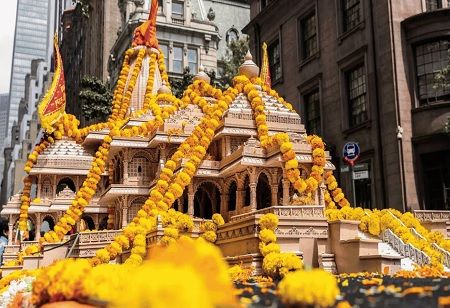
India Day Parade in New York Celebrates Diversity Amid Controversy Over Ram Mandir Float

 The 42nd India Day Parade in New York celebrated the nation’s cultural richness and religious diversity while marking the Indian diaspora’s pride in their homeland. Thousands of people marched down Madison Avenue, witnessing a vibrant display of India’s unity in diversity, highlighted by a prominent float depicting the Ayodhya Ram Mandir.
The 42nd India Day Parade in New York celebrated the nation’s cultural richness and religious diversity while marking the Indian diaspora’s pride in their homeland. Thousands of people marched down Madison Avenue, witnessing a vibrant display of India’s unity in diversity, highlighted by a prominent float depicting the Ayodhya Ram Mandir.
This year’s parade showcased a confluence of different faiths and communities. Alongside the Ram Mandir float were tableaus representing various religious groups, including Muslims, Christians, Sikhs, Jews, and Buddhists. The celebration of this diversity was underscored by the sight of men and women dressed in colorful traditional attire, beating drums from Maharashtra as they heralded the Ram Mandir float. Spectators, in an outpouring of enthusiasm, rushed past barriers to greet it.
The event, attended by thousands of marchers and onlookers, took a celebratory tone despite attempts by a Muslim organization to disrupt the parade. The Indian American Muslim Council (IAMC) organized a campaign to ban the Ram Mandir float, labeling it a symbol of “Muslim hate” and “bigotry.” The group, joined by representatives of Sikhs, Christians, and Hindus, appealed to public officials, demanding the float be excluded. However, the parade proceeded as planned, offering a vibrant contrast to the targeted criticism and the alleged Hinduphobia circulating in certain segments of the US media ahead of the event.
Swami Adveshanand Giri, the leader of the Juna Akhada, the largest and oldest order of sanyasis, was the parade’s chief guest, adding spiritual significance to the event. Bollywood actress Sonakshi Sinha served as the Grand Marshal, accompanied by actor Zahir Iqbal as the VIP guest. The New York Police Department (NYPD) also participated in the parade, with a contingent of officers and their band marching alongside Indian American communities. The NYPD Desi Society held its banner high, showcasing solidarity with the Indian diaspora.
Among the various floats, one carried the theme 'Stop Hindu Genocide in Bangladesh', drawing attention to attacks on Hindus in that country. The float was notable for the participation of a man waving an Israeli flag, symbolizing the shared concerns of Jews and Israelis against the groups ideologically aligned with those opposing the Ram Mandir float. The International Organisation of Bene Israel – USA, representing India’s Jewish community, also participated in the parade.
Diversity was further celebrated with floats dedicated to Guru Teg Bahadur, a Sikh leader, and others from the National Association of Indian Christians proclaiming messages of love and peace. Muslims for Peace also presented a float with the slogan, 'Love to All, Hatred to None'. Additionally, a float honoring Dr. B.R. Ambedkar, the architect of India’s Constitution, was accompanied by the distribution of his works on social justice.
Several cultural performances, including traditional folk dances and music, added to the festive atmosphere of the parade. Various professional organizations, including those of doctors, businesses, and media outlets, also contributed floats.
Despite the buildup of tension over the Ram Mandir float, protests against the parade were minimal. A video truck hired by the IAMC displayed messages like 'New Yorkers Say No to Islamophobia' and 'NY Against Hindutva' before the parade began, but it failed to overshadow the day’s celebration.
The 42nd India Day Parade ultimately stood as a testament to the unity of the Indian diaspora, reflecting a mosaic of faiths, cultures, and traditions coming together in a vibrant display of national pride.